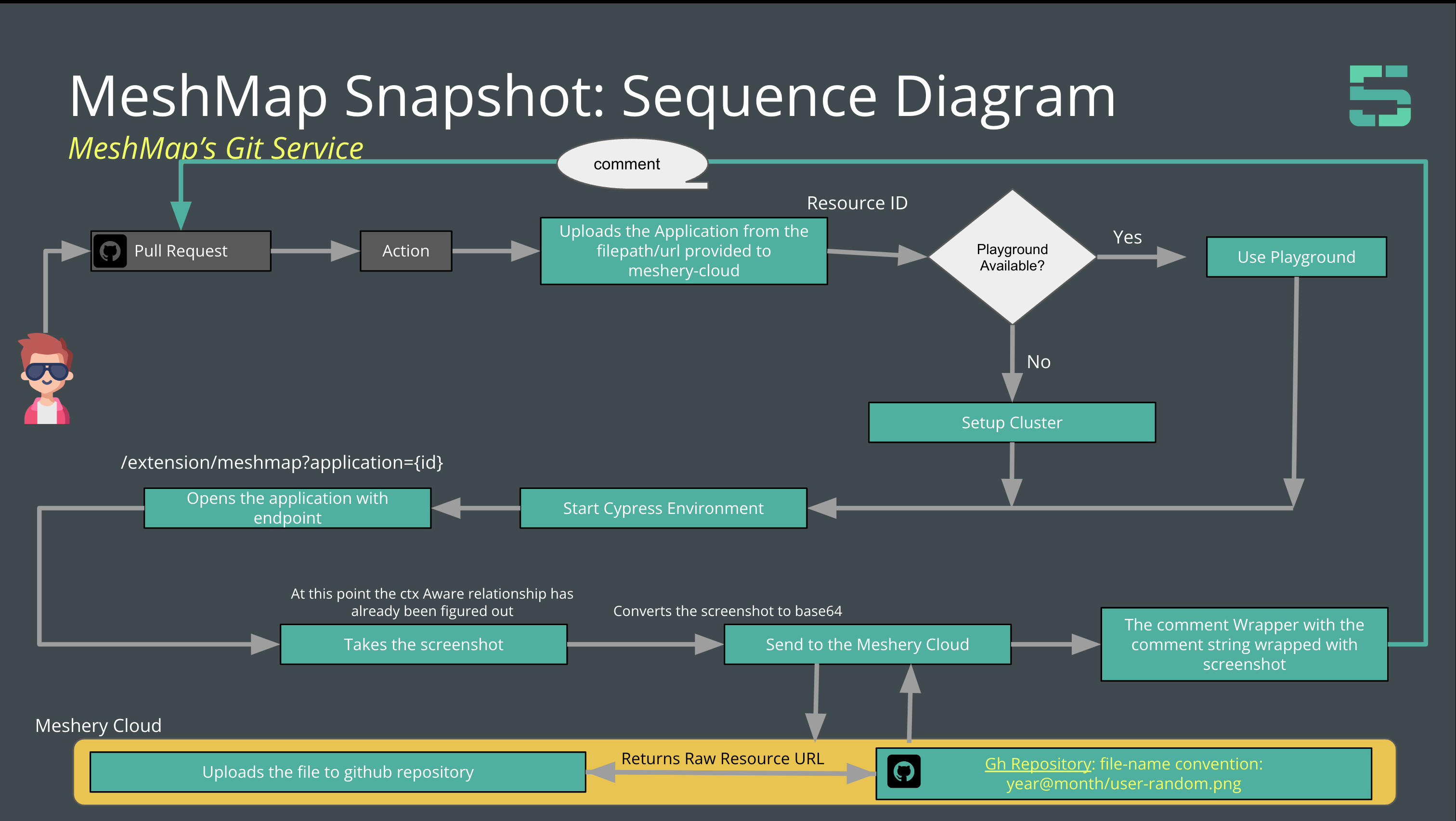Give your pipelines super powers with Meshery's GitHub Actions.
- See your deployment before you merge
- Connect MeshMap to your GitHub repo and see changes pull request-to-pull request
- Get snapshots of your infrastructure directly in your PRs
MeshMap Snapshot is a screenshot service provided via MeshMap for the design or Application user is interested in. It Enables users to visualize the changes being done in the code-base rapidly over each PR and inform the user about any potential changesin their infrastructure. It doesn't need any configuration or setup neither any deployment by the client rather a simple one time setup is able to provide a long time value.
name: 'MeshMap Snapshot With File-located in Fs'
on: # rebuild any PRs and main branch changes
pull_request:
push:
branches:
- main
- master
- 'releases/*'
jobs:
test: # make sure the action works on a clean machine without building
runs-on: ubuntu-latest
steps:
- name: Set PR number # To comment the final status on the Pull-request opened in any repository
run: |
export pull_number=$(jq --raw-output .pull_request.number "$GITHUB_EVENT_PATH")
echo "PULL_NO=$pull_number" >> $GITHUB_ENV
- uses: actions/checkout@v3 # the repository where your infrastructure is located
- uses: actions/checkout@v3 #this step would go and would be no longer needed to be written
with:
path: action
repository: layer5labs/meshmap-snapshot
- id: test_result
uses: layer5labs/[email protected]
with:
githubToken: ${{ secrets.GITHUB_TOKEN }} # github's personal access token example: "ghp_...."
providerToken: ${{ secrets.PROVIDER_TOKEN }} # Meshery Cloud Authentication token, signin to meshery-cloud to get one, example: ey.....
prNumber: ${{ env.PULL_NO }} # auto-filled from the above step
application_type: "Kubernetes Manifest" # your application type, could be any of three: "Kubernetes Manifest", "Docker Compose", "Helm Chart"
filePath: "action/__tests__/manifest-test" # relative file-path from the root directory in the github-runner env, you might require to checkout the repository as described in step 2name: 'MeshMap Snapshot With URL-Upload'
on: # rebuild any PRs and main branch changes
pull_request:
push:
branches:
- main
- master
- 'releases/*'
jobs:
test: # make sure the action works on a clean machine without building
runs-on: ubuntu-latest
steps:
- name: Set PR number # To comment the final status on the Pull-request opened in any repository
run: |
export pull_number=$(jq --raw-output .pull_request.number "$GITHUB_EVENT_PATH")
echo "PULL_NO=$pull_number" >> $GITHUB_ENV
- uses: actions/checkout@v3 #this step would go and would be no longer needed to be written
with:
path: action
repository: layer5labs/meshmap-snapshot
- id: test_result
uses: layer5labs/[email protected]
with:
githubToken: ${{ secrets.GITHUB_TOKEN }} # github's personal access token example: "ghp_...."
providerToken: ${{ secrets.PROVIDER_TOKEN }} # Meshery Cloud Authentication token, signin to meshery-cloud to get one, example: ey.....
prNumber: ${{ env.PULL_NO }} # auto-filled from the above step
application_type: "Helm Chart" # your application type, could be any of three: "Kubernetes Manifest", "Docker Compose", "Helm Chart"
application_url: "https://github.com/meshery/meshery.io/raw/master/charts/meshery-v0.6.88.tgz"The filesystem-approach asks for your relative file-path and automatically merges all the yaml files together to bundle up into one. So you might like to give the root directory where all the yamls are located. It doesn't move recursevely in internal folders, so only the first level yaml files are checked.
designId: # id of input #deprecated
description: "The design uuid, example: 3c116d0a-49ea-4294-addc-d9ab34210662"
required: false
default: '{}'
applicationId: #deprecated
description: "The application uuid, example: 3c116d0a-49ea-4294-addc-d9ab34210662"
required: false
githubToken:
description: "Github PAT token"
required: true
providerToken:
description: "Meshery Authentication Provider Token"
required: true
prNumber:
description: "The Pull request on which comment has to be made"
required: false
default: 0
filePath:
description: "The relative filepath of the location where the manifests are stored"
required: false
application_type:
description: "Application upload type, any of the three, Kubernetes Manifest, Docker Compose, Helm Chart"
required: true
application_url:
description: "Application's source url where the manifests or data is stored"
required: falseAfter testing you can create a v1 tag to reference the stable and latest V1 action
Our projects are community-built and welcome collaboration. 👍 Be sure to see the Layer5 Community Welcome Guide for a tour of resources available to you and jump into our Slack!
MeshMates are experienced Layer5 community members, who will help you learn your way around, discover live projects and expand your community network. Become a Meshtee today!
Find out more on the Layer5 community.

✔️ Join any or all of the weekly meetings on community calendar.
✔️ Watch community meeting recordings.
✔️ Access the Community Drive by completing a community Member Form.
✔️ Discuss in the Community Forum.
✔️Explore more in the Community Handbook.
Not sure where to start? Grab an open issue with the help-wanted label.

